
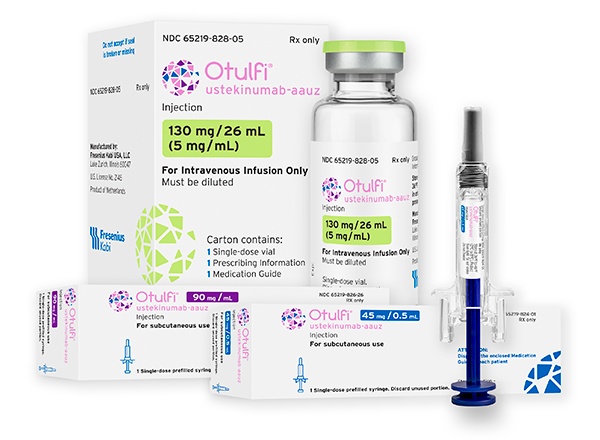
ОТУЛЬФІ 90 мг РОЗЧИН ДЛЯ ІН'ЄКЦІЙ У ПЕРЕДНАПОВНЕНИХ ШПРИЦАХ


Інструкція із застосування ОТУЛЬФІ 90 мг РОЗЧИН ДЛЯ ІН'ЄКЦІЙ У ПЕРЕДНАПОВНЕНИХ ШПРИЦАХ
Введення
Опис: інформація для пацієнта
Отульфі 90мг розчин для ін'єкцій у попередньо наповненому шприці
устекінумаб
Цей лікарський засіб підлягає додатковому моніторингу, що прискорить виявлення нової інформації про його безпеку. Ви можете допомогти, повідомивши про будь-які побічні ефекти, які ви могли б мати. Остання частина розділу 4 містить інформацію про те, як повідомляти про ці побічні ефекти.
Прочитайте уважно весь опис перед тим, як почати використовувати цей лікарський засіб, оскільки він містить важливу інформацію для вас.
Цей опис написаний для особи, яка використовує лікарський засіб. Якщо ви батько або опікун дитини, якій буде введено Отульфі, будь ласка, прочитайте цю інформацію уважно.
- Збережіть цей опис, оскільки вам може знадобитися знову його прочитати.
- Якщо у вас є якісь питання, проконсультуйтеся з вашим лікарем або фармацевтом.
- Цей лікарський засіб призначений тільки для вас, і не слід давати його іншим особам, навіть якщо вони мають相同ні симптоми, оскільки це може нашкодити їм.
- Якщо ви відчуваєте побічні ефекти, проконсультуйтеся з вашим лікарем або фармацевтом, навіть якщо це побічні ефекти, які не вказані в цьому описі. Див. розділ 4.
Зміст опису
- Що таке Отульфі і для чого він використовується
- Що потрібно знати перед тим, як почати використовувати Отульфі
- Як використовувати Отульфі
- Можливі побічні ефекти
- Збереження Отульфі
- Зміст упаковки та додаткова інформація
1. Що таке Отульфі і для чого він використовується
Що таке Отульфі
Отульфі містить активну речовину "устекінумаб", моноклональне антитіло. Моноклональні антитіла - це білки, які ідентифікують і зв'язуються з певними білками організму.
Отульфі належить до групи лікарських засобів, званих "імунодепресантами". Ці лікарські засоби діють шляхом ослаблення частини імунної системи.
Для чого використовується Отульфі
Отульфі використовується для лікування наступних запальних захворювань:
- Псоріаз на плаці - у дорослих і дітей від 6 років і старше
- Псоріатичний артрит - у дорослих
- Хвороба Крона середньої та важкої форми - у дорослих
Псоріаз на плаці
Псоріаз на плаці - це захворювання шкіри, яке викликає запалення, що впливає на шкіру і нігті. Отульфі зменшує запалення та інші ознаки захворювання.
Отульфі використовується у дорослих з псоріазом на плаці середньої та важкої форми, які не можуть використовувати циклоспорин, метотрексат або фототерапію, або коли ці лікування не діють.
Отульфі використовується у дітей і підлітків від 6 років і старше з псоріазом на плаці середньої та важкої форми, які не можуть терпіти фототерапію або інші системні терапії, або коли ці лікування не діють.
Псоріатичний артрит
Псоріатичний артрит - це запальне захворювання суглобів, яке зазвичай супроводжується псоріазом. Якщо у вас активний псоріатичний артрит, спочатку ви будете отримувати інші лікарські засоби. Якщо ви не реагуєте добре на ці лікарські засоби, ви можете бути behandлені Отульфі для:
- Зменшення ознак і симптомів захворювання.
- Поліпшення вашої фізичної функції.
- Зменшення ушкодження суглобів.
Хвороба Крона
Хвороба Крона - це запальне захворювання кишечника. Якщо у вас хвороба Крона, спочатку ви будете отримувати інші лікарські засоби. Якщо ви не реагуєте добре на ці лікарські засоби, ви можете бути behandлені Отульфі для зменшення ознак і симптомів захворювання.
2. Що потрібно знати перед тим, як почати використовувати Отульфі
Не використовуйте Отульфі
- Якщо ви алергічні на устекінумабабо на будь-які інші компоненти цього лікарського засобу (перелічені в розділі 6).
- Якщо у вас є активна інфекція, яку ваш лікар вважає важливою.
Якщо ви не впевнені, чи стосується вас будь-який з цих пунктів, проконсультуйтеся з вашим лікарем або фармацевтом перед тим, як використовувати Отульфі.
Попередження та обережність
Проконсультуйтеся з вашим лікарем або фармацевтом перед тим, як почати використовувати Отульфі. Ваш лікар перевірить, як ви себе відчуваєте перед кожним лікуванням. Переконайтеся, що ви повідомили вашому лікареві про будь-яке захворювання, яке ви маєте, перед кожним лікуванням. Ваш лікар також запитає, чи були ви недавно поруч з людиною, яка могла б мати туберкульоз. Ваш лікар огляне вас і зробить тест на виявлення туберкульозу перед тим, як використовувати Отульфі. Якщо ваш лікар вважає, що ви перебуваєте в групі ризику туберкульозу, він може призначити вам лікарські засоби для лікування.
Обережно слідкувати за важкими побічними ефектами
Отульфі може викликати важкі побічні ефекти, включаючи алергічні реакції та інфекції. Ви повинні бути обережні щодо певних ознак захворювання під час використання Отульфі. Див. повний перелік цих побічних ефектів у розділі "Важкі побічні ефекти" розділу 4.
Перед тим, як використовувати Отульфі, повідоміть вашому лікареві:
- Якщо ви мали алергічну реакцію на устекінумаб.Проконсультуйтеся з вашим лікарем, якщо ви не впевнені.
- Якщо ви мали будь-який вид раку- це тому, що імунодепресанти типу Отульфі ослаблюють частину імунної системи. Це може збільшити ризик розвитку раку.
- Якщо ви приймали лікування псоріазу іншими біологічними препаратами(лікарський засіб, виготовлений з біологічної речовини і зазвичай вводиться шляхом ін'єкції) - ризик розвитку раку може бути вищим.
- Якщо у вас є нова травма або зміни травмвсередині області псоріазу або на здоровій шкірі.
- Якщо у вас є інфекція.
- Якщо ви мали алергічну реакцію на ін'єкцію Отульфі. Див. "Обережно слідкувати за важкими побічними ефектами" у розділі 4 для ознак алергічної реакції.
- Якщо ви приймаєте інші лікарські засоби для лікування псоріазу та/або псоріатичного артриту- такі як інші імунодепресанти або фототерапія (коли ваш організм обробляється певним типом ультрафіолетового світла (УФ)). Ці лікарські засоби також можуть ослаблювати частину імунної системи. Не було проведено дослідження щодо використання цих лікарських засобів разом з Отульфі. Однак це може збільшити ймовірність розвитку захворювань, пов'язаних з ослабленою імунною системою.
- Якщо ви приймали ін'єкції для лікування алергії- не відомо, чи може Отульфі впливати на ці лікарські засоби.
- Якщо вам 65 років або старше- ви маєте більший ризик розвитку інфекцій.
Якщо ви не впевнені, чи стосується вас будь-який з цих пунктів, проконсультуйтеся з вашим лікарем або фармацевтом перед тим, як використовувати Отульфі.
Деякі пацієнти мали реакції, подібні до системного червоного вовчака, під час лікування устекінумабом, включаючи червоний вовчак шкіри або синдром, подібний до червоного вовчака. Проконсультуйтеся з вашим лікарем негайно, якщо ви маєте червону, підвищену та лущену шкіру, іноді з темнішим краєм, на ділянках шкіри, відкритих до сонця, або якщо вони супроводжуються больовими суглобами.
Серцеві напади та інсульт
У одному з досліджень пацієнтів з псоріазом, які приймали устекінумаб, було спостережено серцеві напади та інсульт. Ваш лікар періодично перевірятиме ваші фактори ризику серцевих захворювань та інсульту, щоб забезпечити їх належне лікування. Шукайте медичної допомоги негайно, якщо ви маєте біль у грудях, слабкість або незвичайне відчуття на одній стороні тіла, параліч обличчя або аномалії мови чи зору.
Діти та підлітки
Не рекомендується використовувати Отульфі у дітей молодших 6 років з псоріазом, а також у дітей молодших 18 років з псоріатичним артритом або хворобою Крона, оскільки це не було вивчено у цій віковій групі.
Використання Отульфі з іншими лікарськими засобами, вакцинами
Повідоміть вашому лікареві або фармацевту:
- Якщо ви приймаєте інші лікарські засоби.
- Якщо ви були щеплені недавно або плануєте отримати вакцину. Не слід вводити певні типи вакцин (живі вакцини) під час використання Отульфі.
- Якщо ви приймали Отульфі під час вагітності, повідоміть лікаря вашої дитини про ваше лікування Отульфі перед тим, як ваша дитина отримає будь-яку вакцину, включаючи живі вакцини, такі як вакцина БЦЖ (використовується для профілактики туберкульозу). Не рекомендується використовувати живі вакцини для вашої дитини впродовж перших 12 місяців після народження, якщо ви приймали Отульфі під час вагітності, якщо тільки лікар вашої дитини не порадить інакше.
Вагітність та лактація
- Якщо ви вагітні, вважаєте, що можете бути вагітні або плануєте завагітніти, проконсультуйтеся з вашим лікарем перед тим, як використовувати цей лікарський засіб.
- Не було спостережено підвищеного ризику вад розвитку у дітей, які були під впливом устекінумабу в утробі. Однак досвід використання устекінумабу у вагітних жінок обмежений. Тому краще уникати використання Отульфі під час вагітності.
- Якщо ви жінка репродуктивного віку, рекомендується уникати вагітності та використовувати відповідні методи контрацепції під час використання Отульфі та протягом принаймні 15 тижнів після останнього лікування Отульфі.
- Устекінумаб може проходити через плаценту до плода. Якщо ви приймали Отульфі під час вагітності, ваша дитина може мати підвищений ризик розвитку інфекції.
- Важливо повідомити лікарям вашої дитини та іншим медичним працівникам, якщо ви приймали Отульфі під час вагітності, перед тим, як ваша дитина отримає будь-яку вакцину. Не рекомендується використовувати живі вакцини, такі як вакцина БЦЖ (використовується для профілактики туберкульозу), для вашої дитини впродовж перших 12 місяців після народження, якщо ви приймали Отульфі під час вагітності, якщо тільки лікар вашої дитини не порадить інакше.
- Устекінумаб може виділятися в грудне молоко у дуже малих кількостях. Повідоміть вашому лікареві, якщо ви годуєте грудьми або плануєте це зробити. Ви та ваш лікар вирішите, чи слід вам годувати грудьми або використовувати Отульфі. Не робіть обидва одночасно.
Водіння транспортних засобів та використання машин
Вплив Отульфі на здатність водити транспортні засоби та використовувати машини є незначним або відсутнім.
Отульфі містить полісорбати
Цей лікарський засіб містить 0,04 мг полісорбату 80 у кожному попередньо наповненому шприці, що відповідає 0,04 мг/мл. Полісорбати можуть викликати алергічні реакції. Повідоміть вашому лікареві, якщо у вас є відомі алергії.
3. Як використовувати Отульфі
Отульфі слід використовувати під керівництвом та наглядом лікаря, який має досвід лікування захворювань, для яких призначений Отульфі.
Завжди слідуйте точно інструкціям з введення цього лікарського засобу, вказаним вашим лікарем. Якщо у вас є питання, проконсультуйтеся з вашим лікарем. Спитайте вашого лікаря, коли вам потрібно робити ін'єкції та про консультації з наглядом.
Яка кількість Отульфі вводиться
Ваш лікар вирішить, яку кількість Отульфі вам потрібно використовувати та тривалість лікування.
Дорослі від 18 років
Псоріаз або псоріатичний артрит
- Рекомендована початкова доза становить 45 мг Отульфі. Пацієнти, які важать більше 100 кг, можуть почати з дози 90 мг замість 45 мг.
- Після початкової дози ви прийматимете наступну дозу через 4 тижні, а потім кожні 12 тижнів. Наступні дози зазвичай такі ж, як і початкова доза.
Хвороба Крона
- Під час лікування лікар введе вам першу дозу близько 6 мг/кг Отульфі шляхом внутрішньовенної інфузії. Після початкової дози ви прийматимете наступну дозу 90 мг Отульфі через 8 тижнів, а потім кожні 12 тижнів шляхом підшкірної ін'єкції.
- У деяких пацієнтів після першої підшкірної ін'єкції вводяться 90 мг Отульфі кожні 8 тижнів. Ваш лікар вирішить, коли вам потрібно зробити наступну ін'єкцію.
Діти та підлітки від 6 років
Псоріаз
- Лікар призначить вам правильну дозу, включаючи кількість (об'єм) Отульфі для ін'єкції, щоб зробити правильну дозу. Відповідна доза для вас залежить від вашої ваги в момент кожної ін'єкції.
- Якщо ваша вага становить від 60 кг до 100 кг, рекомендується доза 45 мг Отульфі.
- Якщо ваша вага становить більше 100 кг, рекомендується доза 90 мг Отульфі.
- Після початкової дози ви прийматимете наступну дозу через 4 тижні, а потім кожні 12 тижнів.
Як вводиться Отульфі
- Отульфі вводиться шляхом підшкірної ін'єкції. Спочатку медичний персонал або медсестра можуть зробити вам ін'єкцію.
- Однак ви та ваш лікар можете вирішити, що ви будете вводити Отульфі самостійно. У цьому випадку ви будете навчені, як вводити Отульфі самостійно. У дітей від 6 років рекомендується, щоб введення Отульфі здійснювалося медичним працівником або опікуном після відповідного навчання.
- Для інструкцій щодо введення Отульфі див. "Інструкції з введення" в кінці цього опису.
Проконсультуйтеся з вашим лікарем, якщо у вас є питання щодо самостійного введення Отульфі.
Якщо ви використали більше Отульфі, ніж потрібно
Якщо ви використали або вам було введено більше Отульфі, ніж потрібно, негайно проконсультуйтеся з вашим лікарем або фармацевтом. Завжди носіть з собою упаковку лікарського засобу, навіть якщо вона порожня.
Якщо ви забули використати Отульфі
Якщо ви забули прийняти дозу, проконсультуйтеся з вашим лікарем або фармацевтом. Не приймайте подвійну дозу, щоб компенсувати забуті дози.
Якщо ви припинили лікування Отульфі
Припинення використання Отульфі не є небезпечним. Однак, якщо ви припините лікування, ваші симптоми можуть повернутися. Якщо у вас є інші питання щодо використання цього лікарського засобу, проконсультуйтеся з вашим лікарем або фармацевтом.
4. Можливі побічні ефекти
Як і всі ліки, цей препарат може викликати побічні ефекти, хоча не всі люди їх відчувають.
Важкі побічні ефекти
Деякі пацієнти можуть мати важкі побічні ефекти, які можуть потребувати термінового лікування.
Алергічні реакції – вони можуть потребувати термінового лікування. Зв’яжіться з вашим лікарем або отримайте термінову медичну допомогу негайно, якщо ви помітите будь-які з наступних ознак.
- Важкі алергічні реакції («анafilaxia») рідкісні у населення, яке використовує устекінумаб (можуть впливати до 1 з 1000 осіб). Ознаки включають:
- важкість дихання та ковтання
- низький кров’яний тиск, який може викликати головокружіння або легкі головні болі
- набряк обличчя, губ, рота або горла.
- Рідкісні ознаки алергічної реакції включають шкірну висипку та кропив’янку (ці можуть впливати до 1 з 100 осіб).
У рідких випадках повідомлялося про алергічні реакції на рівні легень та запалення легень у пацієнтів, які приймали устекінумаб. Повідомте вашому лікареві негайно, якщо у вас є симптоми, такі як кашель, важкість дихання та гарячка.
Якщо у вас є важка алергічна реакція, ваш лікар може вирішити, що ви не повинні використовувати Отульфі знову.
Інфекції – вони можуть потребувати термінового лікування. Зв’яжіться з вашим лікарем негайно, якщо ви помітите будь-які з цих ознак.
- Інфекції носа або горла та загальна простуда часті (можуть впливати до 1 з 10 осіб).
- Інфекції легень рідкісні (можуть впливати до 1 з 100 осіб).
- Запалення тканин під шкірою («целюліт») рідкісне (може впливати до 1 з 100 осіб).
- Герпес (тип болючої висипки з пухирями) рідкісний (може впливати до 1 з 100 осіб).
Отульфі може впливати на вашу здатність боротися з інфекціями. Деякі з них можуть бути важкими та викликані вірусами, грибами, бактеріями (включаючи туберкульоз) або паразитами, та включають інфекції, які виникають переважно у осіб з ослабленою імунною системою (опортуністичні інфекції). Повідомлялося про опортуністичні інфекції мозку (енцефаліт, менінгіт), легень та очей у пацієнтів, які приймали лікування устекінумабом.
Ви повинні стежити за ознаками інфекції, поки використовуєте Отульфі. Ці ознаки включають:
- гарячка, симптоми грипу, нічні поти, вагова втрата
- чуття втоми або важкості дихання; кашель, який не проходить
- шкірна гарячка, червоність та біль або болюча висипка шкірної поверхні з пухирями
- свербіння при сечовипусканні
- діарея
- погіршення зору або втрата зору
- головний біль, напруження шиї, світлочутливість, нудота або сплутаність.
Зв’яжіться з вашим лікарем негайно, якщо ви помітите будь-які з цих ознак інфекції, оскільки вони можуть бути ознаками інфекцій, таких як інфекції легень, шкірні інфекції, герпес або опортуністичні інфекції, які можуть мати важкі ускладнення. Також повідомте вашому лікареві, якщо у вас є будь-який тип інфекції, який не проходить або повторюється. Ваш лікар може вирішити, що ви не повинні використовувати Отульфі, поки інфекція не пройде. Також зв’яжіться з вашим лікарем, якщо у вас є будь-яка відкрита рана або виразка, яка може інфікуватися.
Відшарування шкіри – збільшення червоності та відшарування шкіри на великій поверхні тіла можуть бути симптомами еритродермії псоріазу або екзфоліативного дерматиту, які є важкими захворюваннями шкіри. Якщо ви помітите будь-які з цих симптомів, ви повинні негайно повідомити вашому лікареві.
Інші побічні ефекти
Часті побічні ефекти(можуть впливати до 1 з 10 осіб):
- Діарея
- Нудота
- Вомітування
- Чуття втоми
- Чуття головокружіння
- Головний біль
- Свербіння («прурит»)
- Біль у спині, м’язах або суглобах
- Біль у горлі
- Червоність та біль у місці ін’єкції
- Синусит
Рідкісні побічні ефекти(можуть впливати до 1 з 100 осіб):
- Дентальні інфекції
- Вагінальні інфекції, викликані дріжджами
- Депресія
- Закупорення або кон’юнктивіт носа
- Кровотеча, синяки, затвердіння, набряк та свербіння у місці ін’єкції
- Чуття слабкості
- Опущення повіки та втягнення м’язів одного боку обличчя («фасіальний параліч» або «Беллський параліч»), який зазвичай тимчасовий
- Зміна псоріазу з червоністю та новою висипкою шкірної поверхні маленькою, жовтою або білою, іноді супроводжуваною гарячкою (пустулярний псоріаз).
- Лущення шкіри (ексфоліація шкіри)
- Акне
Рідкісні побічні ефекти(можуть впливати до 1 з 1000 осіб):
- Червоність та відшарування шкіри на великій поверхні тіла, яке може викликати свербіння або біль (екзфоліативний дерматит). Можуть розвиватися подібні симптоми, як зміна природних симптомів псоріазу (еритродермія псоріазу)
- Запалення малих кров’яних судин, яке може викликати висипку шкірної поверхні з маленькими червоними або фіолетовими пухирями, гарячку або біль у суглобах (васкуліт)
Дуже рідкісні побічні ефекти(можуть впливати до 1 з 10 000 осіб)
- Пухирі на шкірі, які можуть бути червоними та викликати свербіння та біль (пухирчастий пемфігус).
- Лупус шкіри або синдром, подібний до лупусу (червона, піднята та лущена висипка шкірної поверхні в місцях, відкритих до сонця, можливо, супроводжувана болями у суглобах).
Повідомлення про побічні ефекти
Якщо ви відчуваєте будь-який побічний ефект, проконсультуйтеся з вашим лікарем або фармацевтом, навіть якщо це можливі побічні ефекти, які не перелічені в цьому листку. Також ви можете повідомити про них безпосередньо через національну систему повідомлення, включену до Додатка V. Повідомляючи про побічні ефекти, ви можете допомогти забезпечити більше інформації про безпеку цього препарату.
5. Зберігання Отульфі
- Тримайте цей препарат поза зоною видимості та досягнення дітей.
- Зберігайте в холодильнику (2°C та 8°C). Не заморожуйте.
- Зберігайте шприц-ін’єктор у зовнішній упаковці, щоб захистити його від світла.
- Якщо це необхідно, окремі шприци-ін’єктори Отульфі також можна зберігати при кімнатній температурі до 30°C протягом одного періоду часу до 30 днів у оригінальній упаковці, щоб захистити їх від світла. Напишіть дату, коли шприц-ін’єктор був видалений з холодильника вперше, та дату, коли його потрібно викинути, у передбачених місцях зовнішньої упаковки. Дата викинення не повинна перевищувати оригінальну дату закінчення терміну зберігання, надруковану на коробці. Як тільки шприц-ін’єктор був зберігався при кімнатній температурі (до 30°C), його не слід знову зберігати в холодильнику. Викиньте шприц-ін’єктор, якщо він не був використаний протягом 30 днів зберігання при кімнатній температурі або з дати оригінальної дати закінчення терміну зберігання,ichever відбувається раніше.
- Не трясіть шприци-ін’єктори Отульфі. Енергійне трясіння може псувати продукт.
Не використовуйте цей препарат:
- Після дати закінчення терміну зберігання, яка вказана на етикетці та упаковці після «CAD». Дата закінчення терміну зберігання – останній день місяця, який вказано.
- Якщо рідина змінила колір, є мутною або містить сторонні частинки, що плавають у ній (див. розділ 6 «Вигляд Отульфі та вміст упаковки»).
- Якщо ви знаєте або вважаєте, що були піддані впливу екстремальних температур (як випадкове нагрівання або заморожування).
- Якщо продукт був енергійно потрясений.
Отульфі призначений для одного використання. Ви повинні викинути непотрібний продукт, який залишається у шприці-ін’єкторі. Лікарські засоби не слід викидати у водопровідні труби чи сміття. Спитайте у вашого фармацевта, як позбутися упаковок та лікарських засобів, які вам більше не потрібні. Таким чином ви допоможете захистити навколишнє середовище.
6. Вміст упаковки та додаткова інформація
Склад Отульфі
- Активний інгредієнт – устекінумаб. Кожен шприц-ін’єктор містить 90 мг устекінумабу в 1 мл.
- Інші компоненти – L-гістидин, полісорбат 80 (E433), сукроза, вода для ін’єкційних препаратів та хлоридна кислота (для регулювання pH).
Вигляд Отульфі та вміст упаковки
Отульфі – прозорий ін’єкційний розчин, безколірний або злегка коричнево-жовтим кольором.
Випускається в упаковці, яка містить 1 шприц-ін’єктор об’єму 1 мл скла для одноразового використання. Кожен шприц-ін’єктор містить 90 мг устекінумабу в 1 мл ін’єкційного розчину.
Власник дозволу на розміщення препарату на ринку
Fresenius Kabi Deutschland GmbH
Else-Kroener-Strasse 1
61352 Bad Homburg v.d.Hoehe
Німеччина
Виробник
Fresenius Kabi Austria GmbH
Hafnerstraße 36
8055 Graz Австрія
Дата останнього перегляду цього листка
Детальна інформація про цей лікарський засіб доступна на сайті Європейського агентства з лікарських засобів: https://www.ema.europa.eu/.
Інструкції з застосування
На початку лікування лікар допоможе вам з першою ін’єкцією. Однак ви та ваш лікар можете вирішити, що ви самі можете вводити Отульфі. У цьому випадку вони навчать вас, як вводити Отульфі. Спитайте у вашого лікаря, якщо у вас є будь-які питання щодо введення ін’єкцій. У дітей віком від 6 років та старше рекомендується, щоб введення Отульфі здійснював лікар або опікун після відповідного навчання.
- Не змішуйте Отульфі з іншими ін’єкційними рідинами.
- Не трясіть шприци-ін’єктори Отульфі. Лікарський засіб може бути пошкоджений, якщо його енергійно потрясати. Не використовуйте лікарський засіб, якщо він був енергійно потрясаний.
Фігура 1 показує, як виглядає шприц-ін’єктор.
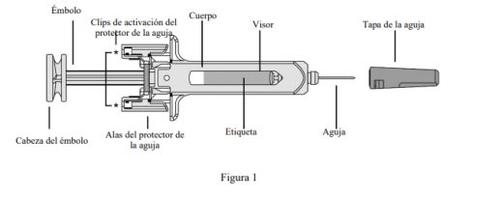
- Перевірте кількість шприців-ін’єкторів та підготуйте матеріали:
Підготовка до використання шприца-ін’єктора
- Видаліть шприц(и)-ін’єктор(и) з холодильника. Покиньте шприц-ін’єктор зовні коробки протягом 30 хвилин. Це дозволить рідині досягнути прийнятної температури для введення (кімнатна температура). Не видаляйте захисник голки, поки чекаєте досягнення кімнатної температури.
- Утримуйте шприц-ін’єктор за корпус з голкою, закритою та спрямованою вгору.
- Не тримайте шприц-ін’єктор за голову поршня, поршень, крила захисника голки або захисник голки.
- Не видаляйте поршень жодного разу.
- Не видаляйте захисник шприца-ін’єктора, поки вам не буде вказано.
- Не торкайтеся кліпів активації захисника голки (позначені зірочками* на Фігурі 1), щоб уникнути того, щоб захисник голки закрив її передчасно.
- Не використовуйте шприц-ін’єктор, якщо він впав на твердій поверхні.
Перевірте шприц(и)-ін’єктор(и), щоб переконатися, що
- Кількість шприців-ін’єкторів та концентрація правильні
- Якщо ваша доза становить 90 мг, у вас буде шприц-ін’єктор об’єму 90 мг Отульфі.
- Це правильний лікарський засіб.
- Дата закінчення терміну зберігання не минула.
- Шприц-ін’єктор не пошкоджений.
- Розчин у шприці-ін’єкторі прозорий та безколірний або злегка коричнево-жовтим.
- Розчин у шприці-ін’єкторі не має аномального кольору, не є мутним або не містить сторонніх частинок, що плавають у ньому.
- Розчин у шприці-ін’єкторі не заморожений.
Підготуйте весь необхідний матеріал та покиньте його на чистій поверхні, включно з антисептичними серветками, ватними підкладками або газами та контейнером для колючих предметів.
- Виберіть та підготуйте місце ін’єкції:
Виберіть місце ін’єкції (див. Фігуру 2).
- Отульфі вводиться шляхом ін’єкції під шкіру (підшкірно).
- Деякі прийнятні місця для ін’єкції – верхня частина стегна або ділянка живота (черевна ділянка) як мінімум у 5 см від пупка.
- Наскільки це можливо, не використовуйте ділянки шкіри, які показують ознаки псоріазу.
- Якщо ін’єкцію здійснює інша особа, то вона також може вибрати верхню частину руки як місце ін’єкції.
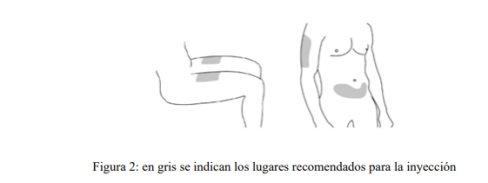
Підготовка місця ін’єкції
- Ви мийте руки добряче з милом та теплою водою.
- Очистіть шкіру місця ін’єкції антисептичною серветкою.
- Не торкайтеся цієї ділянки знову перед ін’єкцією.
- Видаліть захисник голки (див. Фігуру 3):
- Захисник голки неповинен бути видалений, поки ви не будете готові до ін’єкції.
- Утримуйте шприц-ін’єктор та тримайте корпус шприца-ін’єктора однією рукою.
- Від'єміть захисник голки та викиньте його. Не торкайтеся поршня під час цього.

- Ви можете помітити повітряну бульку у шприці-ін’єкторі або краплю рідини на кінці голки. Обидва ці варіанти нормальні та не потребують видалення.
- Не торкайтеся голки та не дозволяйте їй торкатися жодної поверхні.
- Не використовуйте шприц-ін’єктор, якщо він впав без захисника голки. Якщо це трапляється, повідомте вашому лікареві або фармацевту.
- Введіть дозу негайно після видалення захисника голки.
- Введіть дозу:
- Утримуйте шприц-ін’єктор однією рукою між вказівним та середнім пальцями, покладіть великий палець на голову поршня та іншою рукою пінчіть шкіру біля місця ін’єкції великим та вказівним пальцями. Не стискайте.
- Не видаляйте поршень жодного разу.
- Зробіть швидкий рух, щоб вставити голку крізь шкіру так далеко, як це можливо (див. Фігуру 4).
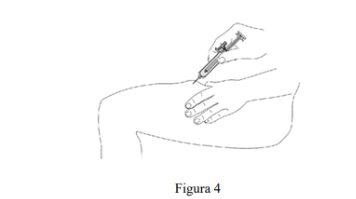
- Введіть весь лікарський засіб, натиснувши на поршень, поки голова поршня не опиниться повністю між крилами захисника голки (див. Фігуру 5).
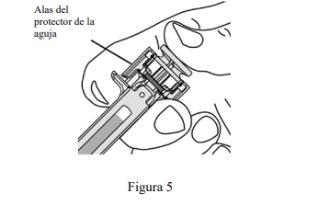
- Коли ви натиснули на поршень так далеко, як це можливо, утримуйте тиск на голові поршня, вийміть голку та звільніть шкіру (див. Фігуру 6).

- Видаліть повільно великий палець з голови поршня, щоб порожній шприц-ін’єктор рухався вперед, поки голка не буде повністю закрита захисником голки, як показано на Фігурі 7:
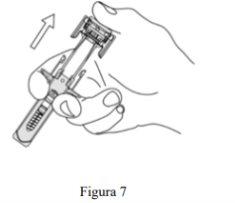
- Після ін’єкції:
- Натисніть на місце ін’єкції антисептичною серветкою протягом кількох секунд після ін’єкції.
- Може з’явитися невелика кількість крові або рідини на місці ін’єкції. Це нормально.
- Ви можете натиснути на місце ін’єкції ватною підкладкою або газою та утримувати протягом 10 секунд.
- Не тертіть шкіру на місці ін’єкції. Ви можете накрити місце ін’єкції пластиром, якщо це необхідно.
- Видалення:
- Використані шприци-ін’єктори повинні бути покладені у контейнер, який не пробивається, подібний до контейнеру для колючих предметів (див. Фігуру 8). За вашу безпеку та здоров’я та за безпеку інших, ніколи не використовуйте шприц-ін’єктор знову. Викиньте контейнер для колючих предметів згідно з місцевими правилами.
- Антисептичні серветки та інші матеріали можуть бути викинуті у сміття.

- Країна реєстрації
- Діючі речовини
- Потрібен рецептТак
- Виробник
- Інформація є довідковою і не є медичною порадою. Перед прийомом будь-яких препаратів обов'язково проконсультуйтеся з лікарем. Oladoctor не несе відповідальності за медичні рішення, прийняті на основі цього контенту.
- Альтернативи до ОТУЛЬФІ 90 мг РОЗЧИН ДЛЯ ІН'ЄКЦІЙ У ПЕРЕДНАПОВНЕНИХ ШПРИЦАХФорма випуску: РОЗЧИН ДЛЯ ІНФУЗІЙ, ЩО ВВОДИТЬСЯ ІН'ЄКЦІЙНО, 130 мгДіючі речовини: ustekinumabВиробник: Accord Healthcare S.L.U.Потрібен рецептФорма випуску: РОЗЧИН ДЛЯ ІН'ЄКЦІЙ, 45 мгДіючі речовини: ustekinumabВиробник: Accord Healthcare S.L.U.Потрібен рецептФорма випуску: РОЗЧИН ДЛЯ ІН'ЄКЦІЙ, 90 мгДіючі речовини: ustekinumabВиробник: Accord Healthcare S.L.U.Потрібен рецепт
Лікарі онлайн щодо ОТУЛЬФІ 90 мг РОЗЧИН ДЛЯ ІН'ЄКЦІЙ У ПЕРЕДНАПОВНЕНИХ ШПРИЦАХ
Консультація щодо дозування, побічних ефектів, взаємодій, протипоказань та поновлення рецепта на ОТУЛЬФІ 90 мг РОЗЧИН ДЛЯ ІН'ЄКЦІЙ У ПЕРЕДНАПОВНЕНИХ ШПРИЦАХ – за рішенням лікаря та згідно з місцевими правилами.





